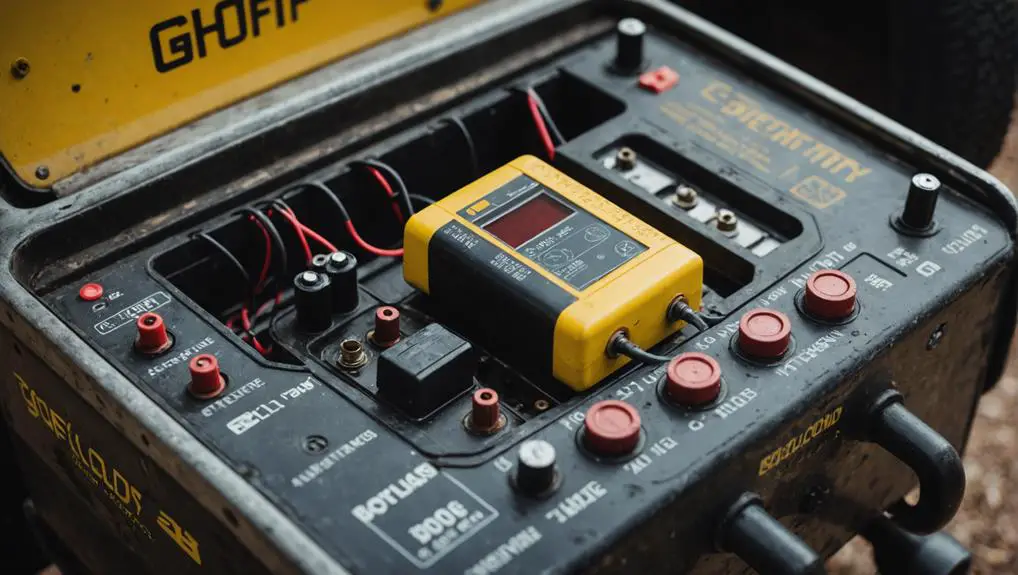Did you know that the type of battery in your cart can dramatically influence how long it runs on a single charge? While lithium-ion batteries often outperform their lead-acid counterparts in both lifespan and efficiency, the terrain you navigate also plays a vital role in battery performance. If you've ever wondered how these factors interact to affect your cart's operational time, the answers might surprise you. Understanding these dynamics can help you make more informed choices about your cart's battery and maintenance needs.
Key Takeaways
- The duration a cart battery lasts on one charge varies based on battery type, weight load, and terrain conditions.
- Flat surfaces yield longer battery life, while inclines and rough terrains drain the battery faster.
- Frequent short trips and heavy loads can significantly reduce overall battery efficiency and lifespan.
- Battery capacity decreases with aging; regular maintenance can help maximize performance.
- On average, a fully charged battery can last anywhere from a few hours to a full day, depending on usage.
Battery Types and Their Lifespan
When it comes to cart batteries, understanding the different battery types and their lifespans is essential for ideal performance. The most common types are lead-acid, lithium-ion, and gel batteries, each offering distinct characteristics that affect lifespan and usability.
Lead-acid batteries typically last between 4 to 6 years, depending on usage and maintenance. They require regular maintenance like water refilling and are sensitive to temperature extremes, which can shorten their lifespan.
On the other hand, lithium-ion batteries can last considerably longer, often exceeding 10 years. They provide higher energy density and faster charging times, making them a popular choice for modern carts. However, their initial cost is generally higher than lead-acid options.
Gel batteries, a subtype of lead-acid, offer a lifespan similar to traditional lead-acid batteries, usually around 5 to 7 years. They're more resistant to vibrations and temperature fluctuations, which enhances their reliability in various environments.
Factors Affecting Battery Life
Several factors influence the lifespan of a cart battery, impacting its overall performance and efficiency. One major element is the charging habits you adopt. Regularly overcharging or undercharging can lead to diminished battery capacity. Additionally, the quality of the charger plays a vital role; using a charger that's not compatible with your battery type can cause irreparable damage.
Another important factor is the battery's maintenance. Failure to keep terminals clean and free from corrosion can affect conductivity, ultimately shortening battery life. Temperature also plays a pivotal role; extreme heat or cold can hinder performance and lead to premature aging. Ideally, keeping the battery within a moderate temperature range will enhance its lifespan.
Usage patterns are equally important. Frequent short trips drain the battery more quickly than longer, sustained use. Moreover, the weight of the load you carry affects battery drain—heavier loads require more energy, reducing overall efficiency.
Lastly, the age of the battery greatly impacts its performance. As batteries age, their ability to hold a charge diminishes, making it essential to monitor their performance and replace them when necessary.
Terrain and Its Impact

Maneuvering different terrains can considerably impact your cart battery's performance and lifespan.
When you're cruising over flat surfaces, your battery generally operates efficiently, consuming less energy. However, as you tackle inclines or uneven ground, your cart requires more power to maintain speed and stability, which can drain the battery faster.
Additionally, rough terrains increase rolling resistance, further straining the battery. If your cart frequently navigates sand, mud, or gravel, you're likely to notice a significant drop in battery life. This is due to the additional energy required to overcome obstacles and maintain traction.
Temperature also plays a significant role; extreme heat or cold can affect battery chemistry, leading to reduced efficiency.
In colder conditions, the battery may lose capacity, while excessive heat can accelerate wear and tear.
Maintenance Tips for Longevity
To guarantee your cart battery lasts as long as possible, regular maintenance is essential. By following a systematic approach, you can enhance the performance and longevity of your battery. Here are three key maintenance tips:
- Check Water Levels: If you're using a flooded lead-acid battery, inspect the water levels regularly. Ascertain the cells are filled with distilled water to prevent damage from sulfation.
- Clean the Terminals: Corrosion can impair the electrical connection, so keep the battery terminals clean. Use a mixture of baking soda and water to remove corrosion, and verify the connections are tight and secure.
- Monitor Charging Practices: Always use a compatible charger and avoid overcharging. Charge your battery after each use, and try not to let it discharge below 50%. This prevents deep cycling, which can lead to premature wear.
Implementing these maintenance tips will help maximize your cart battery's lifespan and efficiency.
Regular attention to these details not only saves you money in the long run but also guarantees your cart performs at its best whenever you need it.
Signs of Battery Wear

Often, battery wear becomes evident through specific signs that indicate it may be time for a replacement. One of the first indicators is a noticeable decline in performance. If your cart struggles to hold a charge or requires frequent recharging after shorter trips, it's a clear signal that the battery is wearing out.
Pay attention to the voltage readings; if they consistently fall below the recommended levels, the battery's capacity is diminishing.
Another sign is physical damage. Inspect the battery for cracks, leaks, or swelling. These issues can compromise functionality and pose safety risks.
Additionally, if you hear unusual sounds—like hissing or bubbling—during charging, that may indicate internal damage or a failure.
You should also monitor charging times. If the battery takes considerably longer to reach a full charge than it used to, this could indicate wear.
Frequently Asked Questions
Can I Use My Cart Battery in Extreme Temperatures?
You can use your cart battery in extreme temperatures, but it's essential to understand the potential risks.
Cold weather can reduce battery efficiency and capacity, while high temperatures may lead to overheating and damage.
It's best to avoid exposing your battery to extreme conditions for extended periods.
If you must operate in such environments, consider using thermal insulation or a battery management system to protect your battery and maintain peak performance.
How Do I Properly Store a Cart Battery?
Storing a cart battery is like tucking a delicate flower into a protective sheath.
You should place it in a cool, dry area away from direct sunlight and extreme temperatures. Disconnect the battery terminals to prevent any accidental discharge, and keep it off the ground to avoid moisture.
Regularly check the charge levels and maintain them as needed. This care guarantees your battery remains vibrant and ready for action when you need it.
What Is the Cost of Replacing a Cart Battery?
Replacing a cart battery typically costs between $800 and $1,500, depending on the brand and type of battery you choose.
You'll want to take into account factors like battery capacity and warranty when making your decision. Additionally, installation costs might apply if you're not doing it yourself.
Always compare options to guarantee you're getting the best value for your investment, as a reliable battery is essential for peak performance and longevity of your cart.
Are There Warranties for Cart Batteries?
Yes, there are warranties for cart batteries, typically offered by manufacturers or retailers.
These warranties often cover defects in materials and workmanship, usually ranging from one to three years.
It's essential to read the terms carefully, as warranties mightn't cover normal wear and tear or damage from misuse.
You should keep your receipt and register your battery to guarantee warranty claims are processed smoothly when needed.
Can I Upgrade My Cart Battery for Better Performance?
Yes, you can upgrade your cart battery for better performance.
Consider higher-capacity batteries that provide more amp-hours, which translates to longer usage times. Verify the new battery fits your cart's specifications, including size and voltage requirements.
Additionally, look into advanced battery technologies like lithium-ion for improved efficiency and reduced weight. Upgrading effectively enhances your cart's speed and range, making your rides more enjoyable and efficient overall.
Conclusion
In conclusion, understanding your cart battery's lifespan is vital for ideal performance. For instance, lithium-ion batteries can last over 10 years compared to lead-acid batteries, which typically last 4 to 6 years. Your runtime largely depends on terrain and usage patterns; rough surfaces can cut battery life drastically. By maintaining your battery properly and recognizing signs of wear, you can maximize its efficiency and guarantee reliable operation for your cart.